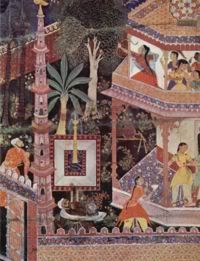Tehseen Baweja
 It was a small living room with around 15 people crammed together, eagerly waiting for Danish to start. I had never listened to him perform but I was still overwhelmed with excitement, I just knew it would be something amazing. Even though he wasn’t in his usual attire of white kurta and topi and sat on a wooden chair instead of the stage with gao-takiya, he created a truly magical atmosphere with this words and expressions, taking everybody into the magical world of warriors and wizards. The 10-minute-and-change dastan performance was probably nothing like they used to have centuries ago, but given that he learnt it on his own, it was an outstanding execution.
It was a small living room with around 15 people crammed together, eagerly waiting for Danish to start. I had never listened to him perform but I was still overwhelmed with excitement, I just knew it would be something amazing. Even though he wasn’t in his usual attire of white kurta and topi and sat on a wooden chair instead of the stage with gao-takiya, he created a truly magical atmosphere with this words and expressions, taking everybody into the magical world of warriors and wizards. The 10-minute-and-change dastan performance was probably nothing like they used to have centuries ago, but given that he learnt it on his own, it was an outstanding execution.
 Danish Hussain is part of a very small team that have taken it on their shoulders to revive the art of daastan goi. Originally a theater artist, Danish came across daastan goi and Mahmood Farooqi during a stage performance, and has been doing daastan performances since. Together, they have done tens of performances in large and small events in India and in Pakistan. In 2007, The Citizens Foundation invited them over to perform in various cities of Pakistan and the outstanding appreciation they received made it clear that they have fans on both sides of the border.
Danish Hussain is part of a very small team that have taken it on their shoulders to revive the art of daastan goi. Originally a theater artist, Danish came across daastan goi and Mahmood Farooqi during a stage performance, and has been doing daastan performances since. Together, they have done tens of performances in large and small events in India and in Pakistan. In 2007, The Citizens Foundation invited them over to perform in various cities of Pakistan and the outstanding appreciation they received made it clear that they have fans on both sides of the border.
Another milestone for them is that the veteran bollywood actor Naseeruddin Shah has committed to perform a daastan with them sometime soon.
Once a very rich and royal form of art, daastan goi slowly blurred and then disappared in early 1900s. The verbal depiction of epics and heroes failed to compete with the fascination that radio sets and cinema created. Historians attribute early Persia as the true breeding ground of daastan goi where story-tellers would narrate the stories of war heroes and their battle against evil. The most famous of these being the stories of a warrior named “Amir Hamza” and his battle against a self-claimed God named “Laqqa”. Passed on to younger generations as a cherished skill, the art of daastan goi flourished in persia for around a thousand years before entering the Indian sub-continent at the time of Mughals. Mughal emperor Akbar, became one of the most significant patrons of this art when he ordered the creation of Hamzanama. Hamzanma contained 1,400 canvas folios with scenes from daastan-e-Amir Hamza painted on the front of the canvas, and the poetic narration inscribed on the back of it. When Hamzanama was finally completed after 15 years, it would serve as the first prototype of television, with two people holding the canvas for the audience to look at the painting while a narrator would stand behind the canvas to recite the inscriptions, creating a grandeur and an unprecedented experience.
daastan goi transferred orally from one generation to another, being patronized by nawabs and such, till it went into non existence in the early twentieth century. The going-away of this art was so unnoticable that the last known dastan go “Mir Baqir” is said to have died in Delhi in extreme poverty , after reverting to selling ‘paan’ as is last livelihood.
I am glad that people like Danish Hussain and Mahmood Farooqi are giving this art a new life by bringing it to masses and allowing us to cherish these magical experiences. Hats off to them!
Credits: Photos are from Wikipedia



















































This is a great art and I hope someone tries to patronize it. I think it could become very popular in Pakistan and also internationally.
Na samjho ge to mit jao ge “Pakistan” walon
Tumhari dastaan tak bhi na hogi dastaanon mein…
Dastaan-goi = medieval, feudal, backward, waste of time, energy, WAPDA, tax-payers money, mourning dead pimps and prostitutes, idhar tum, udhar hum, suqoot-e-Dhaka, the party is not over, I will tear up another Poland resolution and rule for 100 years ( through Zardari !)
The art of tableau vivant (dastan goi) in which the artists dress and pose while not speaking nor moving is quite alive and well (or used to be during my school days) in Pakistan.
Our Christian compatriots performed it for the nativity plays at my school, the Cathedral of Lahore.
As a young child, I used to look forward to attending them. It was a time we would see our teachers dressed in costumes and performing various parts. It was fun. It heralded the winter breaks. And it was a great introduction to Christianity. Of course, we never bought that the male teachers who acted as
Wow. I was not familiar with their work but now I definitely look forward to it.
Dont forget the contribution of Zia Mohiuddin in the revival of this art too…..